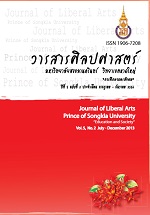Developing Ability to Translate Homonyms and Homographs via Training in Part of Speech Identification and Dictionary Use
Keywords:
Ability to translate, homonyms, homographs, training in part of speech identification and dictionary useAbstract
The purposes of this classroom-based research were 1) to investigate the effectiveness of training in part of speech identification and dictionary use in order to develop the ability to select appropriate meanings of English homonyms and homographs of 30 EFL undergraduate students enrolled in a translation class 2) to identify factors the students perceived as affecting their competence in selecting the right meanings of the homonyms and homographs and 3) to explore their attitudes towards the training. The instruments used in the research were: 1) the training worksheets consisting of 60 target homonyms and homographs chosen from the General Service List of most frequent words of English 2) the pre-post tests consisting of 20 target words not included in the worksheets, and 3) two questionnaires on factors the students perceived as affecting their ability in sense selection of words with multiple meanings and attitudes toward the training. The findings showed that their post-test scores were significantly higher than their pre-test scores at the level of .05. This revealed that the training benefited the students in their sense selection of multi-meaning words. Results also showed that vocabulary skill was regarded as the most influential factor affecting their sense selection. The majority of the subjects had positive attitudes toward the training; the training in part of speech identification could make them more able to select meanings appropriate to the context and the training in dictionary use was considered useful in translation class.
Downloads
Published
How to Cite
Issue
Section
License
Copyright (c) 2016 วารสารศิลปศาสตร์ มหาวิทยาลัยสงขลานครินทร์ วิทยาเขตหาดใหญ่ (Journal of Liberal Arts Prince of Songkla University Hat Yai)

This work is licensed under a Creative Commons Attribution-NonCommercial-NoDerivatives 4.0 International License.
The authors retain the copyright to their article but the Journal of Liberal Arts, Prince of Songkla University reserves the exclusive rights to first publication.






